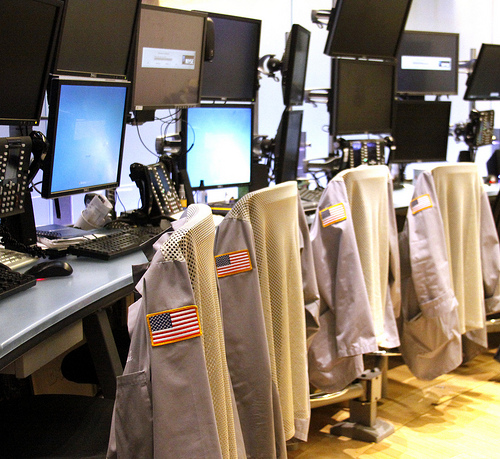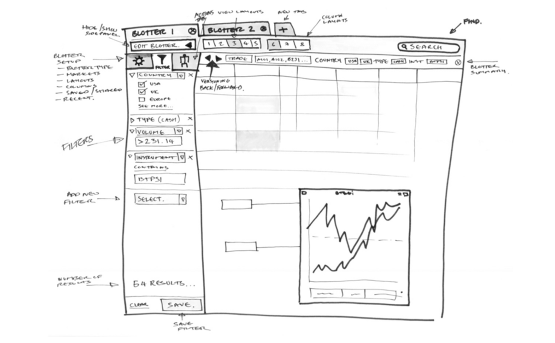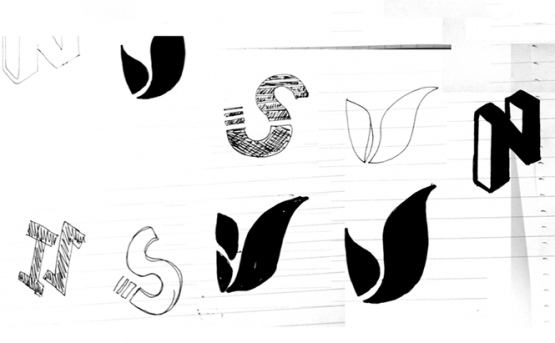Publicly, we often refrain from talking about most of our client work and instead focus on promoting and sharing our own experiences through our own ustwo™ apps, games and other unique IP.
However, what most people don’t know is that 90% of our business is about getting stuck into the deeper design challenges that our clients come to us with. This is where our expertise and input can fundamentally affect the final product in a profound way.

We’re given an opportunity to use a combination of our UX, UI and development skills together, to create solutions to overcome these challenges.
In this post I’d like to highlight a few experiences working with one of our clients… a global investment bank. My aim is to look at some of the key challenges we faced working within this area of business and share some general tips.
To set the tone I’d like to start with some observations we gleaned by spending time on the trading floor:
The Environment
Despite impressions to the contrary, traders are not Wall Street-esque alpha males barking orders whilst taking huge financial risks. They consist of a range of personality types, are 100% focused on their work and are actually very risk adverse.
Forget those pre-conceived views of the trading floor because things are very different in reality. Although there’s a varying degree of noise from traders, TVs and general hubbub – it’s generally a very electronically focused area with lots of people working with multi-monitor computer setups.

Benefiting from change
As with most people used to working with tried and tested systems and setups, change can often be a difficult subject to broach. When we asked what they’d most like to see changed, their response was often, “nothing, it’s fine as it is.”
It was our responsibility to highlight the design opportunities that would help improve overall user experience and lead to increased efficiency. It also meant that working collaboratively with the traders was of paramount importance. Actively involving them at appropriate stages of project development, listening to and implementing their feedback meant that we achieved a sense of ownership early on.

Introducing new concepts
We’ve seen an increased reliance on digital technology and good user experience and interface design is now becoming a main area of focus for many businesses.
There are numerous opportunities to share and highlight the benefits of a User Centred Design approach during the earlier stages of projects, especially to those stakeholders less au fait with software and product design. Our aim was to turn skeptics to advocates as quickly as possible.
* * * * *
These cornerstone observations, although basic, helped us adapt our approach, which in the long run meant we focused on the most important aspects, meeting all parties’ objectives.
It was clear a 4-6 week discovery phase with an accompanying tome would not cut the mustard in this fast paced, results driven environment. So we focused on immediately demonstrating tangible deliverables and benefits as early as we could.
With the right team in place we were in a position to provide some instant UX and UI recommendations on their current systems based purely on our experience, expertise and heuristic evaluation alone.
We initially focused on an appropriate standalone area of functionality, which quickly allowed us to produce some UX and UI concepts. We then presented these to the stakeholders demonstrating our approach and focus on the project from the get go.
Looking back at the early concepts and comparing them to what was ultimately delivered, it’s of course very different, but the exercise served its purpose in garnering trust and advocacy amongst the key people whose support was needed in order to move the project forwards.
A few interesting things we learnt from this project
**1. Never underestimate the instant difference in quality of UX and UI you can provide a company in an industry not used to design **
It's easy to assume that other industries are up to full speed when it comes to UX and UI, but this is not the case. What you may consider as slightly underdeveloped UX and UI design can actually be a revelation to others.
2. Branding is important for the design and development of internal projects
External branding is created to appeal to external audiences, so it’s not appropriate to translate its use for the design and development of internal projects. Therefore considered and relevant branding is required when building an internal application for a number of purposes.
In this particular case, we created a brand based on the values we felt the system should instil, with a name, logo, colour palette, templates and guidelines. The idea was to create a ‘real’ fully branded product, which not only looked professional but also allowed all parties to believe in it and to generate a true sense of ownership.

With our newly created set of assets and supporting guidelines in place, implementation of great UX and UI was a much easier process. Finally, it meant that the final product really stood out from the other applications.
3. Importance of focusing on inclusive collaboration on all levels when needed
If only it was as simple as designing and delivering a great product. In reality, there are however numerous considerations on a whole range of levels that need addressing throughout the process. Getting buy-in from all involved is crucial and our core aim was to really make our client feel like part of the project team. We wanted everyone involved developing ideas through participatory design sessions in workshops, all helping to shape the process at regular stages.
Meetings and presentations from the get go and at key stages weren’t an easy thing to facilitate in this environment, but it meant we avoided many more in the long run.
I’ve only scratched the surface when it comes to the details of this project, but the main point is to always be adaptable and flexible in your approach. In the long run it will pay dividends and before you know it, the product you’ve spent months or even years working on, will finally be ‘out there’, being used in the real world as it was intended to, by the users it was made for.
In our case the launch of this product was made entirely without training. The users just picked it up and ran with it. We were lucky enough to be able to quantitively measure the effectiveness of our work from launch and within one week of going live, we saw a 30% increase in its efficiency. That is a result!